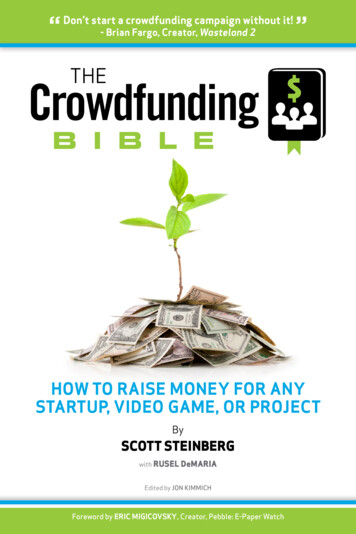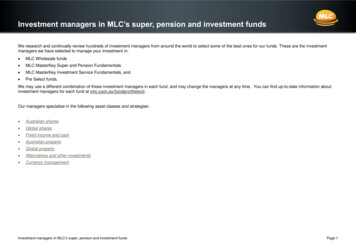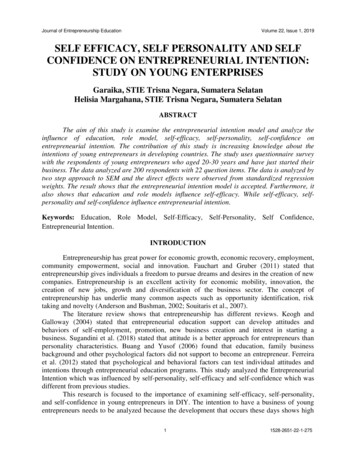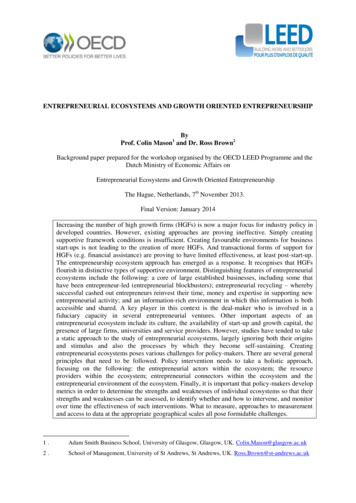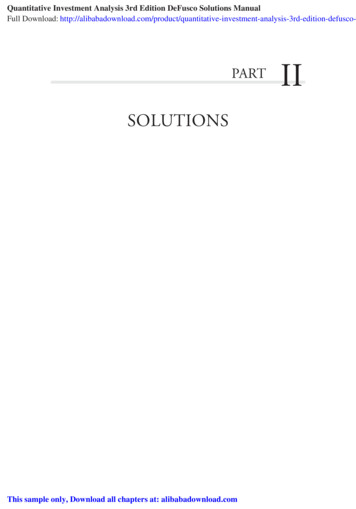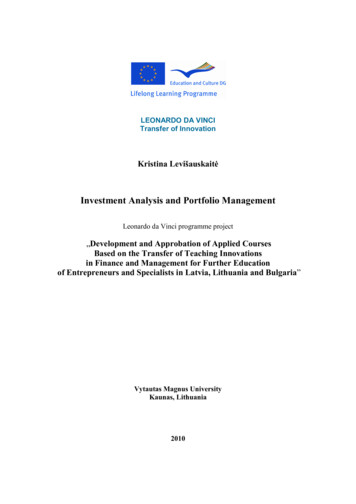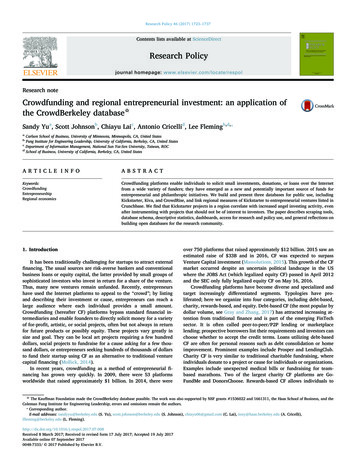
Transcription
Research Policy 46 (2017) 1723–1737Contents lists available at ScienceDirectResearch Policyjournal homepage: www.elsevier.com/locate/respolResearch noteCrowdfunding and regional entrepreneurial investment: an application ofthe CrowdBerkeley database MARKSandy Yua, Scott Johnsonb, Chiayu Laic, Antonio Cricellid, Lee Flemingb,d,⁎aCarlson School of Business, University of Minnesota, Minneapolis, CA, United StatesFung Institute for Engineering Leadership, University of California, Berkeley, CA, United StatescDepartment of Information Management, National Sun Yat-Sen University, Taiwan, ROCdSchool of Business, University of California, Berkeley, CA, United StatesbA R T I C L E I N F OA B S T R A C TKeywords:CrowdfundingEntrepreneurshipRegional economicsCrowdfunding platforms enable individuals to solicit small investments, donations, or loans over the Internetfrom a wide variety of funders; they have emerged as a new and potentially important source of funds forentrepreneurial and philanthropic initiatives. We build and present three databases for public use, includingKickstarter, Kiva, and CrowdRise, and link regional measures of Kickstarter to entrepreneurial ventures listed inCrunchbase. We find that Kickstarter projects in a region correlate with increased angel investing activity, evenafter instrumenting with projects that should not be of interest to investors. The paper describes scraping tools,database schema, descriptive statistics, dashboards, access for research and policy use, and general reflections onbuilding open databases for the research community.1. IntroductionIt has been traditionally challenging for startups to attract externalfinancing. The usual sources are risk-averse bankers and conventionalbusiness loans or equity capital, the latter provided by small groups ofsophisticated investors who invest in return for a share of the venture.Thus, many new ventures remain unfunded. Recently, entrepreneurshave used the Internet platforms to appeal to the “crowd”; by listingand describing their investment or cause, entrepreneurs can reach alarge audience where each individual provides a small amount.Crowdfunding (hereafter CF) platforms bypass standard financial intermediaries and enable founders to directly solicit money for a varietyof for-profit, artistic, or social projects, often but not always in returnfor future products or possibly equity. These projects vary greatly insize and goal. They can be local art projects requiring a few hundreddollars, social projects to fundraise for a cause asking for a few thousand dollars, or entrepreneurs seeking hundreds of thousands of dollarsto fund their startup using CF as an alternative to traditional venturecapital financing (Mollick, 2014).In recent years, crowdfunding as a method of entrepreneurial financing has grown very quickly. In 2009, there were 53 platformsworldwide that raised approximately 1 billion. In 2014, there wereover 750 platforms that raised approximately 12 billion. 2015 saw anestimated raise of 33B and in 2016, CF was expected to surpassVenture Capital investment (Massolutions, 2015). This growth of the CFmarket occurred despite an uncertain political landscape in the USwhere the JOBS Act (which legalized equity CF) passed in April 2012and the SEC only fully legalized equity CF on May 16, 2016.Crowdfunding platforms have become diverse and specialized andtarget increasingly differentiated segments. Typologies have proliferated; here we organize into four categories, including debt-based,charity, rewards-based, and equity. Debt-based CF (the most popular bydollar volume, see Gray and Zhang, 2017) has attracted increasing attention from traditional finance and is part of the emerging FinTechsector. It is often called peer-to-peer/P2P lending or marketplacelending; prospective borrowers list their requirements and investors canchoose whether to accept the credit terms. Loans utilizing debt-basedCF are often for personal reasons such as debt consolidation or homeimprovement. Prominent examples include Prosper and LendingClub.Charity CF is very similar to traditional charitable fundraising, whereindividuals donate to a project or cause for individuals or organizations.Examples include unexpected medical bills or fundraising for teambased marathons. Two of the largest charity CF platforms are GoFundMe and DonorsChoose. Rewards-based CF allows individuals to The Kauffman Foundation made the CrowdBerkeley database possible. The work was also supported by NSF grants #1536022 and 1661311, the Haas School of Business, and theColeman Fung Institute for Engineering Leadership; errors and omissions remain the authors.⁎Corresponding author.E-mail addresses: sandyyu@berkeley.edu (S. Yu), scott.johnson@berkeley.edu (S. Johnson), chiayu06@gmail.com (C. Lai), tony@haas.berkeley.edu (A. Cricelli),lfleming@berkeley.edu (L. 7.008Received 8 March 2017; Received in revised form 17 July 2017; Accepted 19 July 2017Available online 07 September 20170048-7333/ 2017 Published by Elsevier B.V.
Research Policy 46 (2017) 1723–1737S. Yu et al.the website a popular platform for the study and analysis of rewardsbased CF. Kiva operates as a non-profit with a mission to fund loans thatalleviate poverty. CrowdRise provides a platform for philanthropic fundraising without expectation of payback to funders.The motivation behind developing these databases is to provideresearchers and policy makers with a comprehensive summary of projects that is as accurate and current as possible (the websites are ideallyscraped and updated daily). Each project page contains a description ofthe project, funds raised, rewards offered, project backers, comments,and updates. The panel data contains daily statistics of number ofbackers, amount funded, number of comments, and number of updatesfor each project while it is live. Kickstarter does not provide full statistics on backers, due to privacy concerns. Due to financial constraints,we unfortunately provide data only on U.S. platforms, though CF isquite popular around the world (Gray and Zhang, 2017). We provide aMetaBase interface for users who are unfamiliar with how to access SQLdatabases and summary statistics and graphical illustrations.To provide an example of the types of research that the databasesenable, the paper explores the impact of Kickstarter campaigns uponregional entrepreneurial funding, by linking Crunchbase data toKickstarter. It appears that Kickstarter campaigns, and technologycampaigns in particular, correlate with an increase the number of angelfunding rounds in a region. The note will conclude by reflecting on thechallenges of building a database for the research community.Appendices include technical details of scraping, database schema andupdating, and user access.Table 1Selected summary statistics scraped from Kickstarter website April 2009 to end ofDecember 2016. Data are slightly greater than Mollick (2014) and appear to include morefailed campaigns (confirmed in personal communication with Ethan Mollick on August 9,2016).Goal (USD)Amount pledged(USD)Backer countComment countCampaign durationHas videoNMeanMinMaxStd 2.00389373.0092.001.00956.511164.0513.040.45fund a project in return for a reward, which can range from a token ofappreciation, such as credits in a movie, to a product or service, such asa beta-version of a product. This form of CF allows entrepreneurs toraise money without incurring debt or sacrificing equity. This is themost widely-known type of CF and examples include Kickstarter andIndiegogo. Equity CF is most akin to angel and VC financing, whereindividuals contribute money in return for shares of a company. Thesecompanies are still early in their lifecycle. Examples of equity crowdfunding platforms include AngelList and CircleUp. Equity CF appears tohave accounted for 7.35% of the total global crowdfunding industry in2015 (Massolutions 2015), hence, most investors do not receive equity.The Fung Institute at UC Berkeley, with the support of the KauffmanFoundation, has assembled a publicly-available database on three CFplatforms to date: Kickstarter, Kiva, and CrowdRise. Kickstarter is thelargest rewards-based crowdfunding website by traffic, number ofbackers, and total dollars pledged (Massolution) and a global industryleader. Kickstarter claims (midway through 2017) to have raised over 3 B since its founding in April 2009, and these successes have made2. The Databases: KickstarterKickstarter (KS) is one of the largest rewards-based CF platformsand includes projects from a diverse set of categories, including technology, food, design, and games. KS data is scraped from publiclyFig. 1. Number of successful and failed Kickstarter campaigns by quarter for all categories in 2016. The campaigns appear seasonal and that seasonality varies slightly by category.1724
Research Policy 46 (2017) 1723–1737S. Yu et al.Fig. 2. Proportions of successful Kickstarter projects since 2009. Crafts and music have become relatively smaller proportions of projects while technology has become a larger proportion.the lender-level, the lender ID, location, loan date, and number of totalloans is collected. Table 2 and Fig. 3 illustrate.Table 2Selected summary statistics scraped from Kiva website, April 2005 to end of December2016.Funded amount (USD)Lender countLoan amount (USD)Repaid amount (USD)NMeanMinMaxStd Dev4. The Databases: 00969.0026.761007.20883.02CrowdRise provides a CF platform for charitable and personalcauses. Example projects include fundraising for charities, medical expenses, personal emergencies, and volunteer projects. CrowdRise datais scraped from publicly accessible campaign pages starting from 2010and includes 491,000 projects (as of April 2017). The collectedvariables include project name, description, organizer, fundraising goal(in USD), fundraised amount (in USD), donation dates, and donorcomments. Table 3 and Fig. 4 illustrate.accessible project pages starting from 2009 and contains 312,000campaigns (as of the end of December 2016). The collected variablesinclude project title, description, location (city, state, country), founderdetails, fundraising goal amount (in USD), actual fundraised amount (inUSD), category, and project status (success, failed, canceled). Furtherdetails on backers, such as comments, are also collected. Selectedsummary statistics are listed in Table 1 and Figs. 1 and 2.5. Does Crowdfunding increase regional entrepreneurial funding?Economic inequality has become a defining controversy of our time(Piketty and Goldhammer, 2014) and seemingly fueled populist reactions around the world, including within the U.S. The differential impact of technological change is cited as one potential cause of this inequality. Recent technological and social change, in the form of theInternet and rise of online CF communities, could increase or decreasethis inequality. It might decrease regional inequality, if it increasesinnovation and entrepreneurship in regions away from traditional hubssuch as Boston and Silicon Valley. It could also increase regional inequality if it drains resources from poorer regions as crowds becomemore aware of distant opportunities and send their money to wealthierregions. Here we provide an example of how these databases might beapplied by investigating if Kickstarter activity in a region leads to anincrease or decrease of entrepreneurial investment, as observed by3. The Databases: KivaKiva is an international nonprofit that provides a CF platform tofund loans to borrowers in developing economies. Kiva lenderscrowdfund on average 2.5 million in loans each week; more than onemillion loans have been funded. Loan amounts start at 25 incrementsand lenders are repaid over time. The Kiva data is scraped from publiclyaccessible loan pages starting from 2005 and contains 1,310,000observations (as of the end of December 2016). Collected variables onthe loan-level include borrower and loan description, borrower location, number of lenders, total loan amount (in USD), and loan status. On1725
Research Policy 46 (2017) 1723–1737S. Yu et al.Fig. 3. Status of repayment of Kiva loans by year.successful Kickstarter campaigns in that region.Crowdfunding might decrease subsequent angel funding in a regionif entrepreneurs substituted crowdsourced investment for angel investment. Alternately, CF might increase subsequent funding if earlyinvestors looked for ideas and the validation of ideas from CFsuccess. Through CF platforms, investors can 1) gain more informationabout market traction and are 2) able to access more deals.Furthermore, several well-known angel investors have become active ininvesting in crowdfunded products or services after successful campaigns (Schroter, 2014). Teasing out these consistent mechanisms empirically strikes us as a fruitful direction for future research.The relationship between CF and investment is difficult to establishwith correlations, as many factors might influence both the number ofCF campaigns and angel investments in a region. Fixed effects modelscould account for some of these factors, such as relatively static variables such as education levels of a workforce, geographical or institutional influences, or even wealth, assuming these do not change quicklyover time. Other co-varying factors could change simultaneously,however; for example, the economic cycle could encourage both CF andangel investments.We employ an instrumental variables approach to ameliorate theseconcerns (as illustrated below, non-instrumented models show similarthough often attenuated relationships). Based on lexical similarity inKickstarter projects and venture capital investments fromVentureXpert, we divide Kickstarter projects into three categories: 1)Table 3Selected statistics scraped from CrowdRise website, Jan 2010 to end of April 2017.Amount raised (USD)Donation countTeam membersNMeanMinMaxStd gel funding rounds in Crunchbase. This becomes an interestingquestion, as CF appears to be relatively stronger in regions with lessventure capital funding, compared with traditional hubs such as SiliconValley and Boston (Sorenson et al., 2016).Crunchbase is an open source database maintained by TechCrunch,a leading technology news site. Although it is open source, Crunchbasehas partnerships with 900 venture capital firms and AngelList toensure their public data is accurately represented. Crunchbase tends tohave more early stage companies, which makes it ideal for examiningnascent ventures and new venture formation. Crunchbase data includesfounder profiles, company location (city, state, country), founding date,business description, funding milestones (date and amount), investors,and operational status (active, acquired, closed, IPO). For this example,company-level data is aggregated to the county level to examine newventure activity in regions across the U.S. In particular, the number ofrounds of angel funding in a region is regressed upon the number of1726
Research Policy 46 (2017) 1723–1737S. Yu et al.Fig. 4. Number of CrowdRise projects by year.that consider the amount of angel funding return similar results). Anincrease in successful Kickstarter projects correlates with angel investments and imposing a time trend indicates that the effect has been increasing over time (though the underlying effect loses significance withinclusion of the interaction effect in Table 5). Table 6 illustrates increased and significant effects when considering only successful Kickstarter technology campaigns. Fig. 7 interprets and graphs effect sizes.It would appear that Kickstarter crowdfunding draws greater entrepreneurial investment to a region, does not act as a substitute forangel investment, and that these trends have increased over time. Bythe end of the time period, it appears that a 1% increase in successfultechnology campaigns corresponds to an increase of over 0.4% in angelinvestments.those of great interest to investors, 2) those of moderate interest, and 3)those of little interest. Fig. 5 illustrates (from Sorenson et al., 2016).Dark rows indicate Kickstarter campaigns with strong lexical overlap(i.e., similar words in their descriptions, see actual overlap in percentages) and include games, food, technology, fashion, crafts, and journalism. Gray rows indicate campaigns of little lexical overlap and include film and video, music, comics, and dance. Note the lack of darkentries in the VentureExpert Biotechnology and Medical/Health columns, which corroborates Kickstarter’s prohibition of biotechnologyand medical campaigns. Note also that this assumes that VentureExpertand Crunchbase investors have similar investment interests. Fig. 6shows the contribution of technology campaigns, campaigns withstrong lexical overlap (games, food, fashion, crafts, and journalism),and campaigns with little lexical overlap over time (film and video,music, comics, and dance).We use the categories with little overlap as an instrument for categories of greatest overlap and do not consider those in the intermediate category. The logic of the exclusion restriction is that theprojects that are not of interest to investors will correlate with theprojects that are of interest, and yet attract no investment and thereforehave no impact on subsequent entrepreneurial investment in the region.(See Supplementary Materials to Sorenson et al., 2016 for details.) TheCragg-Donald F statistic is 5999.56, indicating a very strong instrument. The amount of patenting and citations to patents in a region (in aparticular year) control for the number and quality of available ideas.Table 4 provides descriptive statistics and 5 considers the relationship between successful Kickstarter projects and the number of angelinvestments in a region, including year and region fixed effects (models6. Reflections and opinions on building databases for the researchcommunityGiven the big investment required to build a database, and the manyand often unanticipated questions that might be answered with it, it is awaste of research investment not to share it widely. Here we reflect onthis process and offer suggestions for those who are considering contributing such a database. Making data public also reflects a nowwidespread trend across all sciences in making data fully accessible,and in particular, data needed to replicate published findings (King,1995).Finding the financial support to build databases is non-trivial andfinding support to host them even more difficult. While most fundingentities support and even require data sharing, reviewers often seem1727
Research Policy 46 (2017) 1723–1737S. Yu et al.Fig. 5. (from Supplementary Materials, Sorenson et al., 2016): Lexical overlap between categories of Kickstarter and VentureExpert. Dark rows indicate strong overlap and are used as anindependent variable; gray rows only indicate weak overlap and are used as an instrument. Remaining rows are not used.scientist has the ability and interest in building a complete database anddocument how to use it. Students (often computer science or engineering majors) are often hired to program and build databases,however, they are usually temporary, rarely understand the context,and approach the problem without an understanding of social sciencemethods. They require a great deal of attention and direction, particularly when it comes to testing and documentation (in particular, it isvery difficult for such students to spot very obvious errors simplethings that would jump out to a social scientist).reluctant to fund research proposals that ask for resources to documentand make data widely available. Proposals that seek to maintain apreviously developed database are particularly unpopular, even thoughinterfaces break, data become outdated, and formats change (scrapingwebsites for data is particularly vulnerable to changes in HTML code).The authors can offer little advice in this regard, except to ask thatreviewers view such requests in a more positive light, and agenciesperhaps allocate some fixed percentage of their support to such efforts.Finding database builders is also no easy task. It is rare that a social1728
Research Policy 46 (2017) 1723–1737S. Yu et al.Fig. 6. Proportions of successful Kickstarter projects by category groups since 2009. Games, food, fashion, crafts, and journalism are categories with strong lexical overlap; film and video,music, comics, and dance are categories with weak lexical overlap. The overall contribution of game and technology campaigns are increasing over time.proves so in another. It is unfortunate but important to keep in mindthat building a general database is a much deeper and more oneroustask than building a database for a narrow set of questions. Users shouldview shared data as the starting point which enables them to build theirown database, not as a ready to analyze off the shelf product.Once the database is built, the author needs to find a server to hostit. We would advise finding Information Technology (IT) professionalsto do this. University IT departments often have the capacity to do thisand can provide firewalls if the author wishes to ask for a login to trackusage (this Crowdfunding database is hosted, for example, by the HaasSchool of Business) or protect sensitive or proprietary data (in particular, care must be taken not to reveal human subjects or financialdata). Harvard’s Institute for Quantitative Social Science (IQSS) hostsDataverse (http://dataverse.org/), a very successful and popular site forsharing databases. The Dataverse also allows easy posting of documentation and accompanying papers, so that authors are more likelyto earn deserved citation credit for their contribution.One last bit of warning to those who offer up a database for generalconsumption. You will receive plaintive emails, some offering veryreasonable and useful feedback, and some asking for help across avariety of topics such as opening a file or writing a dissertation. Theserequests are best received with appreciation and patience, respectively.Table 4Descriptive statistics for main variable.ObsNumber of successfulcampaignsNumber of successfulcampaigns (technologyonly)Number of angel investmentsNumber of patentsNumber of citationsMeanStd. 6803.460.000.000.0071.0025956.00426996.00Errors are endemic to databases and often seem to multiply likeweeds once you start looking. Users have little tolerance for them andwill sometimes malign the probity of the author, even when the datawere shared with the best of intentions. Errors arise from no end ofsources: bad original data (which then get blamed on the author),changes in data format (often undocumented by the original source),changes in website architecture which then breaks a scraping tool,simple programming errors, size problems, and inadequate softwareand/or hardware. Users can be exceptionally helpful in debugging adatabase, though this requires an IT infrastructure and process forgathering, tracking, and acting on feedback (which is quite costly). Thisprocess of improving accuracy also tends to be very research questionspecific a database that has proven accurate in one context rarely7. Conclusion and possibilitiesWe have scraped, built databases, and provided public interfaces forthree prominent Crowdfunding platforms, including Kickstarter, Kiva,1729
Research Policy 46 (2017) 1723–1737S. Yu et al.Table 5Naïve regressions (models 1-2), estimate of instrument strength (campaigns not of interest to Angel investors, model 3), and two-stage least squares instrumental variable regressionestimates of the effect of successful Kickstarter campaigns on the number of future angel investments (models 4-5), with two-way (year and county) fixed effects for 3225 counties over 7years.1) Count of Angel Investments2) Count of Angel Investments0.0699***(0.00235) 0.000962(0.00612)0.0147***(0.00117)KS SuccessfulKS Successful x timeIV KS Cragg-Donald Wald F-StatR-squaredNumber of 0413(0.00255)22,57522,5750.0493,2250.0573,2253) First Stage0.455***(0.00588) 3,2254) Count of Angel Investments5) Count of Angel 343,2250.0433,225Table 6Naïve regressions (models 1-2), estimate of instrument strength (campaigns not of interest to Angel investors, model 3), and two-stage least squares instrumental variable regressionestimates of the effect of successful technology Kickstarter campaigns on the number of future angel investments (models 4-5), with two-way (year and county) fixed effects for 3225counties over 7 years.1) Count of AngelInvestmentsKS Successful (Tech only)0.137***(0.00429)KS Successful (Tech only) x time2) Count of AngelInvestments3) First Stage0.130***(0.0130)0.00140(0.00242)IV KS Cragg-Donald Wald F statR-squaredNumber of **(0.00350)-0.0310***(0.00267) 0.0148***(0.00183)22,5751961.73,2254) Count of AngelInvestments5) Count of Angel 143***(0.00239)0.00462***(0.000986)22,57522,575 0.0403,2250.0353,225ventures because the financial barriers to entry become too low. If thecrowd is not adept at evaluating projects with financial potential, verylow quality projects may get funded by a CF platform. If this is the case,one might expect lower amounts of subsequent financing and higherfailure rates within a region. CF activity probably impacts particularindustries more heavily. Furthermore, if CF is indeed successful in encouraging entrepreneurship in a region, then one would expect thedistribution of firms to change in that region over time.Finally, does CF funding go to richer or poorer regions, and if so,where does that funding come from (Burtch et al., 2014)? Are richerregions sources or sinks of CF funding? If CF flowed from rich topoor regions, it could be a viable mechanism to decrease regional inequality. On the other hand, if we observed money flowing from poor torich regions, this would appear to heighten inequality. This mechanismmay vary by the definition of rich and poor (for example, population,per capital income, distance from an urban center). One can estimatedyadic models of flows between all pairs of counties, controlling fordistance and other observed covariates.and CrowdRise. The underlying databases are in SQL and will be updated daily; more databases may follow. To illustrate how such databases might be used, we established that the number of angel fundingrounds in a region correlates with the number of Kickstarter campaigns.To strengthen causal inference, we applied a lexical overlap methodthat separated campaigns of interest to investors (such as technology)from those of little or no interest (such as arts and philanthropy). Fromthese instrumented regressions, it appears more likely that technologycampaigns have a strong, positive, and recently increasing impact onangel funding in a region.The databases provide a number of future research opportunities.For example, CF campaigns might improve the quality of entrepreneurial ventures and/or select out the best opportunities. If thewisdom of the crowd evaluates projects correctly (Mollick and Nanda,2015), the quality of new firms, as measured by subsequent financing orthe proportion of successful firms, should increase within a region.Founding rates may drop, but ultimate success rates may go up. Alternately, CF activity might decrease the average quality of new1730
Research Policy 46 (2017) 1723–1737S. Yu et al.Fig. 7. Instrumented impact of 1) all successful Kickstarter campaigns onsubsequent entrepreneurial firm starts in a region and 2) just successfultechnology campaigns.AppendicesAccessing CrowdBerkeley DatabasesThe main website for CrowdBerkeley is http://www.crowd.berkeley.edu and the databases can be accessed at: https://crowdfunding.haas.berkeley.edu/wp/. To download selections from the database, simply register an email address. Once logged in users can submit SQL queries to thedatabase under the “Scraped Public Database” tab (see Fig. 8). This tab also has a drop-down menu with sample SQL queries. To allow access withouta knowledge of SQL, we use Metabase, located at http://fung-datascience.coe.berkeley.edu/. Accessing the data requires an email address ending in@gmail.com.Coding detailsInitial database setupThe basic pipeline for populating the database was to first download the complete HTML for projects into an intermediate database, writescrapers to parse the raw HTML, and extract the desired information to the main database. This process is illustrated in Fig. 9 and is described indetail below. All code for downloading and parsing the HTML was written in Python.The URLs for each project are needed in order to scrape the project data. Our initial source of URLs was Webrobots.io, a website which providesvarious scraping and crawling services. Their data contained the URLs from almost every project on Kickstarter as of their last scrape, as well aslocation information for each project. The location data was stored in the location table
size and goal. They can be local art projects requiring a few hundred dollars, social projects to fundraise for a cause asking for a few thou-sand dollars, or entrepreneurs seeking hundreds of thousands of dollars to fund their startup using CF as an alternative
